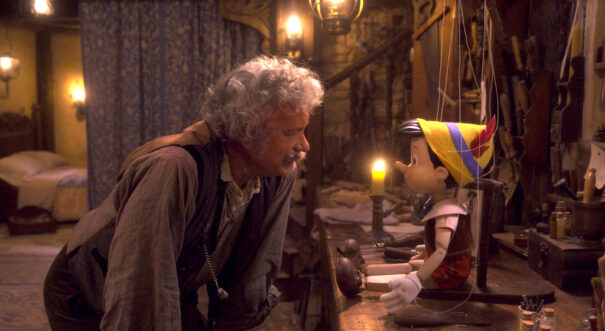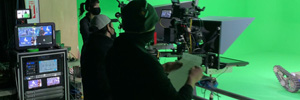Disney’s ‘Pinocchio’ used Ultimatte 12 and HyperDeck Studio 4K Pro for virtual production pipeline
The live action version of the animated classic film, Disney’s Pinocchio, used Ultimatte 12 real time compositing processors and HyperDeck Studio 4K Pro (Design Blackmagic) broadcast decks as part of the production’s massive virtual production workflow.
Starring Tom Hanks as Geppetto, the live action and CGI retelling of the epic journey of a wooden puppet who becomes a real boy, Pinocchio used one of the largest virtual production workflows for any feature film and included several massive sets at Cardington Stage in London.
Director, Virtual Production and SVP Dimension North America, Jim Geduldick was the virtual production supervisor for Pinocchio. “He and his team were responsible for integrating Simulcam, the live compositing of virtual objects with live action, with Unreal Engine’s real time 3D CGI creations, allowing any member of the crew, as well as the actors, to be able to control or react to virtual objects in real time. While using Simulcam and Unreal Engine for virtual production had been done in the past, Geduldick was faced with doing this on a scale that had never been attempted.
To accomplish this, Geduldick created several virtual production carts that were built around Ultimatte 12s, Ultimatte Smart Remote 4 and HyperDeck Studio 4K Pros which could be quickly moved anywhere they were needed on set.
“No one had ever tried to do this across multiple sets for three months straight. There was so much happening each day, and we had to make sure we could get a cart wherever and whenever they were needed,” Geduldick said. “We could not have done that without Ultimatte and HyperDeck.”
Fluxo de trabalho
Each cart included multiple Ultimatte 12s, Ultimatte Smart Remote 4 and HyperDeck Studio 4K Pros. At first Geduldick used two Ultimatte 12s per Simulcam feed, but with software improvements to Ultimatte 12 from Blackmagic Design, by the end of production he was able to use a single Ultimatte 12 per Simulcam setup.
“The workflow used Simulcam with layers of augmented CG layers and Ultimatte 12 as the keyer. The images were then integrated into Motor irreal in real time. We could do front plates and back plates through a single Ultimatte, and we relied on the Ultimatte’s hardware based processing to send a real time key to Unreal,” Geduldick noted.
He continued: “You can’t beat Ultimatte’s hardware based real time keying. Offloading to hardware saves so much data use that is needed elsewhere on set.”
HyperDeck Studio 4K Pros were used to create custom playlists along with basic playback and recording. This helped create a workflow where virtual elements and specific lighting setups could be played back through Unreal Engine.
“The Simulcam and Ultimatte workflow was amazing. The DP, VFX supervisor and camera operators would know where they were landing because they could see it using Ultimatte. Lighting and atmospheric decisions could be done right on set. Virtual production only works if you can react and make creative decisions in real time, and that is what the Blackmagic Design products allowed,” Geduldick finished.
Gostou deste artigo?
Assine nosso feed RSS e você não vai perder nada.

















